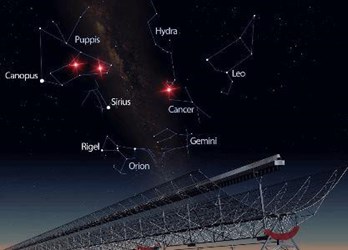SKA Pathfinder Telescope Detects 3 New Fast Radio Bursts

The Molonglo telescope – an SKA pathfinder telescope located some 40km from the Australian capital Canberra – has been used to detect 3 new fast radio bursts (FRBs), it was announced last week.
Fast Radio Bursts are millisecond-duration intense pulses of radio light that appear to be coming from vast distances. They are about a billion times more luminous than anything we have ever seen in our own Milky Way galaxy and have so far eluded any explanation.
Ms Manisha Caleb, currently undertaking her PhD at the Australian National University, Swinburne University of Technology and CAASTRO, developed software to sift through the 1 PB of data produced each day by the telescope, and in the process discovered these three FRBs.
“Until now we only knew of 18 FRBs, so every new detection is key to cracking the mystery of what causes them.” said Manisha. “It’s fantastic to be able to use such a telescope and contribute to the research on these unknown phenomena as a PhD student. With this experience, I’m hopeful that I’ll be able to contribute to the SKA in the future!”
SKA Project Scientist Evan Keane added: “It’s great to see the upgraded Molonglo breaking new ground in the hunt for FRBs and adding new pieces to the puzzle. As a pathfinder, this is very much in line with future observations with the SKA, as we expect to detect many precisely located FRBs in real time on a daily basis. This will allow us to use them as unique astrophysical tools to trace out the cosmic web and intergalactic magnetic fields, as well as study the evolution of the Universe and measure dark energy.”
Since 2013 the Molonglo telescope has been undergoing an upgrade to transform it into a FRB hunting telescope as part of a project called UTMOST (upgrade of the Molonglo Observatory Synthesis Telescope). Its large collecting area by today’s standards (18,000 square metres – 1.8% of the full SKA) and large field of view (eight square degrees on the sky) make it an excellent telescope for this purpose.
Source: SKA
